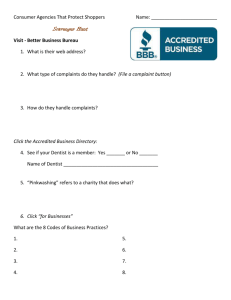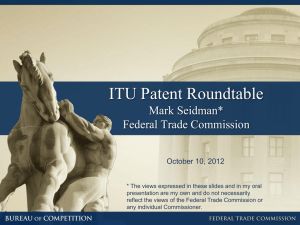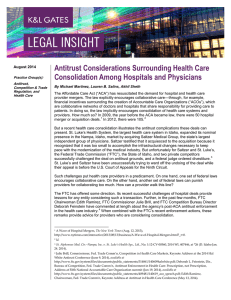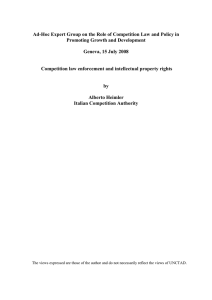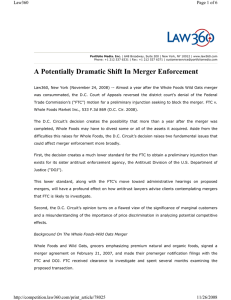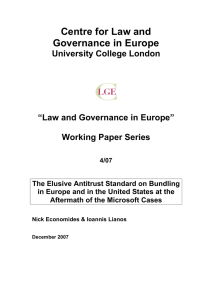Ad-Hoc Expert Group on the Role of Competition Law and
advertisement
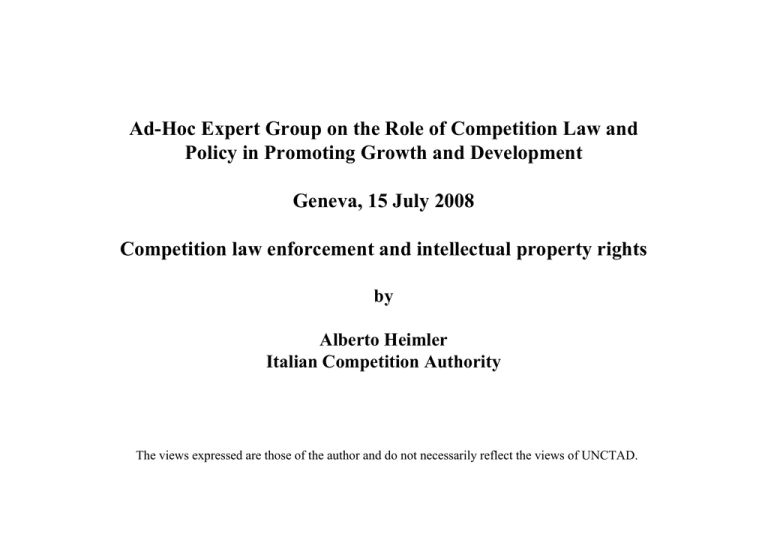
Ad-Hoc Expert Group on the Role of Competition Law and Policy in Promoting Growth and Development Geneva, 15 July 2008 Competition law enforcement and intellectual property rights by Alberto Heimler Italian Competition Authority The views expressed are those of the author and do not necessarily reflect the views of UNCTAD. Competition law enforcement and intellectual property rights Alberto Heimler Italian Competition Authority Geneva, July 2008 Is there a difference between intellectual and physical property? • Inventions and innovations are public goods: no rivalry in consumption and no appropriability • The objective of IP rights is to exclude others from exploiting a non physical asset. The same principles of exclusion holds for physical property. • Like with physical property, the right to exclude associated with IP rights does not imply market power and indeed most patents are of little use • IP rights (patents) provide an incentive for R&D, they make it possible to publicize an invention and facilitate licensing Antitrust enforcement • Restrictive agreements are prohibited. Major controversy: what is the counterfactual: a less restrictive agreement or no agreement? • The abuse of a dominant position is prohibited. Major controversy: does the law protect competitors or the consumer? • Merger control. Major problem: the evaluation is forward looking. Major controversy: what is the time horizon of the prospective analysis? • Important to remember: Antitrust does not prohibit the creation or the strengthening of a dominant position per se (only if achieved via a merger) Innovation and merger control • The problem is that a merger may affect the ability of firms to bring innovations to the market • Genzyme-Novazyme (FTC 2004): both firms active in the treatment of Pompe disease. The problem was whether R&D would diminish as a consequence of the merger . The FTC approved it (but two years after it had been completed) • Shell-Basf (EC 2000) JV likely to create a dominant position in markets associated with polypropylene and polyethylene. The EC approved with commitments to license third parties. Know-how to produce was insufficient and nobody entered Licensing agreements I • They are evaluated under a rule of reason standard: the agreement may be prohibited if it restricts competition that would have existed without the agreement (major worries: coordination of pricing or of output; foreclosure of access to inputs). • 2 producers established in 2 different countries agree to cross license 2 competing technologies and agree not to compete • A drug manufacturer in country A signs an exclusive agreement with a distributor in country B with a no export clause • Licensing between non competitors are OK Licensing agreements II • Portfolio cross licenses and patent pools favor the commercialization of new products (especially patent pools that are open to licensing). They are pro-competitive when patents are complementary. The problem is that very often patents are both complementary and substitutes. • Summit and Visx (FTC 1998) created a patent pool for the production of lasers employed in performing eye surgery. The agreement was considered restrictive • Rambus (FTC 2006) monopolized 4 markets of computer memory technologies (Standard for DRAM chips) by hiding the existence of its patents in the process of standard setting Refusal to deal • It may be prohibited if a firm has market power and refuses to deal with customers • In the US (Kodak, 1992 and Aspen, 1985) an indication for the existence of an abuse is that access be denied when it had been granted in the past. Plus of course that there are no satisfactory business justifications for it • In the EC a refusal is an abuse when it is likely to eliminate competition in a market and access is indispensable (Oscar Bronner, 1999). • In the EC Magill (1995), IMS (2004), Microsoft (2004): a new product must be denied to consumers. No indications on pricing. Tie-ins and bundling • A tie-in: the sale of one product (the tying good) on the condition that the buyer purchase another product • Bundling: a package of two or more products (pure-mixed) • US Microsoft case (1994): PC manufacturers had to pay Microsoft in any case • US Microsoft case (2001): bundling Windows with Internet Explorer (the problem was Windows) • EC Microsoft case (2004): bundling of Windows with Media player (no economies from integration) • South Korea Microsoft case (2004): bundling of Windows with messenger services Other exclusionary conduct • Shering Plough (FTC, 2003): reverse payment in a case on counterfeiting. Shering Plough paid (60 and 10 million $) 2 generic manufactures in order for them not to produce (formally in exchange for the use of 2 irrelevant licenses). The FTC blocked the agreement. The 11th circuit reversed. US DOJ not in line with FTC • Astra Zaneca (EC 2005): abused its dominant position with its product Losec by misleading representation with patent offices and deregistration. The case is under appeal Parallel trade and exhaustion • Parallel trade impedes price discrimination that very often is pro-competitive (leading to increase in the quantities produced). In pharmaceuticals price regulation through averaging is very similar to parallel trade. If parallel trade exists the incentive to price discriminate is reduced • Micro leader (ECJ 1999): copyright law is a justification for Microsoft prohibition of exporting Windows from Canada to France. However that prohibition is subject to antitrust scrutiny • In Australia in 1998 parallel trade for recorded music was liberalized. The ACCC concluded a number of cases against the Majors because they impeded parallel trade.


